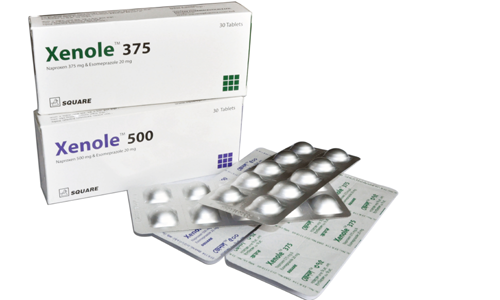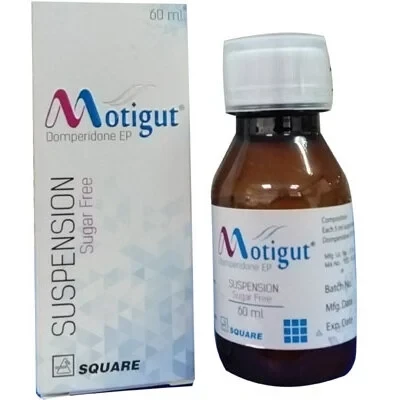



Xenole Tablet (Delayed Release), Naproxen Sodium + Esomeprazole Magnesium 375 mg+20 mg
Inhouse product
-
৳11.40
৳12.00 -
৳42.75
৳45.00 -
৳16.63
৳17.50 -
৳2.14
৳2.25
Reviews & Ratings
Indications
Xenole tablet is
indicated for the relief of signs & symptoms of-
- Osteoarthritis
- Rheumatoid arthritis
- Ankylosing spondylitis &
- To decrease the risk of
developing gastric ulcers in patients at risk of developing
NSAID-associated gastric ulcers.
* রেজিস্টার্ড চিকিৎসকের পরামর্শ মোতাবেক ঔষধ সেবন করুন'
Pharmacology
This consists of an
immediate release Esomeprazole Magnesium layer & an enteric-coated Naproxen
core. As a result, Esomeprazole is released first into the stomach, prior to
the dissolution of Naproxen in the small intestine.
Naproxen is a NSAID with analgesic & antipyretic properties. The mechanism
of action of Naproxen is to inhibit the prostaglandin synthesis. Esomeprazole
is a proton pump inhibitor that suppresses gastric acid secretion by specific
inhibition of the H+/k+ -ATPase in the
gastric parietal cell by acting specifically on the proton pump, Esomeprazole
blocks the final step in acid production, thus reducing gastric acidity.
Dosage
Carefully consider the
potential benefits & risks of this tablet & other treatment options
before deciding to use this tablet. Use the lowest effective dose for the
shortest duration consistent with individual patient treatment goals. If a dose
of Esomeprazole lower than a total daily dose of 40 mg is more appropriate, a
different treatment should be considered.
Rheumatoid Arthritis, Osteoarthritis and Ankylosing Spondylitis-
- Adults: One tablet twice daily of either: 375 mg naproxen/20
mg of esomeprazole; or 500 mg naproxen/20 mg of esomeprazole
Juvenile Idiopathic
Arthritis in Adolescent Patients 12 Years of Age & Older-
- Weight greater
than 50 kg: 375 mg naproxen/20 mg of
esomeprazole; or 500 mg naproxen/20 mg of esomeprazole
- Weight 38 kg to
less than 50 kg: One tablet twice daily of 375
mg naproxen/20 mg of esomeprazole.
* রেজিস্টার্ড চিকিৎসকের পরামর্শ মোতাবেক ঔষধ সেবন করুন'
Administration
Do not split, chew,
crush or dissolve the tablet. This tablet is to be taken at least 30 minutes
before meals.
* রেজিস্টার্ড চিকিৎসকের পরামর্শ মোতাবেক ঔষধ সেবন করুন'
Interaction
With medicine:
- Concomitant use of NSAIDs may
reduce the antihypertensive effect of ACE inhibitors, diuretics &
beta-blockers
- Concomitant use of this tablet
and warfarin may result in an increased risk of a bleeding complication.
- Esomeprazole inhibits gastric
acid secretion & may interfere with the absorption of drugs where
gastric pH is an important determinant of bioavailability (eg.
Ketoconazole, iron salts and digoxin).
With food &
others: Administration of Naproxen & Esomeprazole together with high-fat
food in healthy volunteers does not affect the extent of absorption of naproxen
but significantly prolongs tmax by 10 hours and
decreases peak plasma concentration (Cmax) by about 12%
Contraindications
- Known hypersensitivity to any
component of this tablet or substituted benzimidazoles.
- History of asthmay urticaria or
other allergic-type reactions after taking aspirin or other NSAIDs.
- Use during the peri-operative
period in the setting of coronary artery bypass graft (CABG) surgery.
Side Effects
Immediate release
esomeprazole has been included in the tablet formulation to decrease the
incidence of gastrointestinal side effects from Naproxen. Naproxen and
Esomeprazole tablet has been shown to significantly decrease the occurrence of
gastric ulcers and NSAID associated upper gastrointestinal adverse events
compared to Naproxen alone. Naproxen: Clinical trial and epidemiological data
suggest that use of coxibs and some NSAIDs (particularly at high doses and in
long-term treatment) may be associated with a small increased risk of arterial
thrombotic events (for example myocardial infarction or stroke). Although data
suggest that the use of Naproxen (1000 mg daily) may be associated with a lower
risk, some risk cannot be excluded. Oedema, hypertension and cardiac failure
have been reported in association with NSAID treatment. The most commonly
observed adverse events are gastrointestinal in nature. Peptic ulcers,
perforation or GI bleeding, sometimes fatal, particularly in older people, may
occur. Nausea, vomiting, diarrhoea, flatulence, constipation, dyspepsia,
abdominal pain, melaena, haematemesis, ulcerative stomatitis, exacerbation of
colitis and Crohn’s disease have been reported following administration. Less
frequently, gastritis has been observed.
Pregnancy & Lactation
Pregnancy: In women attempting to conceive or during
the first and second trimester of pregnancy, Naproxen and Esomeprazole tablet
should not be given unless the potential benefit to the patient outweighs the
potential risk to the foetus. Naproxen and Esomeprazole tablet is
contraindicated during the third trimester of pregnancy.
Breast-feeding: Naproxen is excreted in low quantities in
human milk. It is unknown whether esomeprazole is excreted in human milk.
Naproxen and Esomeprazole tablet should not be used during breastfeeding.
Fertility: The use of NSAIDs like Naproxen may impair
female fertility. The use of Naproxen and Esomeprazole tablet is not
recommended in women attempting to conceive.
Precautions & Warnings
General: The combination of Naproxen and Esomeprazole
tablet and NSAIDs including cyclooxygenase-2 selective inhibitors should be
avoided because of the cumulative risks of inducing serious NSAID-related
adverse events. Naproxen and Esomeprazole tablet can be used with low dose
acetylsalicylic acid. Undesirable effects may be minimized by using the lowest
effective dose for the shortest duration necessary to control symptoms.
Risk-factors to develop NSAID related gastro-intestinal complications include
high age, concomitant use of anticoagulants, corticosteroids, other NSAIDs
including low-dose acetylsalicylic acid, debilitating cardiovascular disease,
Helicobacter pylori infection, and a history of gastric and/or duodenal ulcers
and upper gastrointestinal bleeding. In patients with the conditions such as
Inducible porphyries, Systemic lupus erythematosis and mixed connective tissue
disease, Naproxen should only be used after a rigorous benefit-risk ratio.
Patients on long-term treatment (particularly those treated for more than a
year) should be kept under regular surveillance.
Older people: Naproxen: Older people have an increased
frequency of adverse reactions especially gastro-intestinal bleeding, and
perforation, which may be fatal. The esomeprazole component of Naproxen and
Esomeprazole tablet decreased the incidence of ulcers in older people.
Gastrointestinal
effects: Naproxen: GI
bleeding, ulceration or perforation, which can be fatal, has been reported with
all NSAIDs at anytime during treatment, with or without warning symptoms or a
previous history of serious GI events. The risk of GI bleeding, ulceration or
perforation with NSAIDs is higher with increasing NSAID doses, in patients with
a history of ulcer, particularly if complicated with haemorrhage or perforation,
and in older people. These patients should begin treatment on the lowest dose
available. Combination therapy with protective agents (e.g. misoprostol or
proton pump inhibitors) should be considered for these patients, and also for
patients requiring concomitant low dose acetylsalicylic acid, or other drugs
likely to increase gastrointestinal risk. Patients with a history of GI
toxicity, particularly older people, should report any unusual abdominal
symptoms (especially GI bleeding) particularly in the initial stages of
treatment. Caution should be advised in patients receiving NSAIDs with
concomitant medications which could increase the risk of ulceration or
bleeding, such as oral corticosteroids, anticoagulants such as warfarin,
selective serotonin-reuptake inhibitors or anti-platelet agents such as
acetylsalicylic acid. When GI bleeding or ulceration occurs in patients
receiving Naproxen and Esomeprazole Tablet, the treatment should be withdrawn.
NSAIDs should be given with care to patients with a history of gastrointestinal
disease (ulcerative colitis, Crohn’s disease) as these conditions may be
exacerbated. Esomeprazole: Dyspesia could still occur despite the addition of
Esomperazole to the combination tablet. Treatment with proton pump inhibitors
may lead to slightly increased risk of gastrointestinal infections such as
Salmonella and Campylobacter. Esomeprazole, as all acid-blocking medicines,
might reduce the absorption of vitamin B12 (cyanocobalamin) due to hypo- or
achlorhydria. This should be considered in patients with reduced body stores or
risk factors of reduced vitamin B12 absorption on long-term therapy.
Cardiovascular and
cerebrovascular effects:
Naproxen: Appropriate monitoring and advice are required for patients with a
history of hypertension and/or mild to moderate congestive heart failure as
fluid retention and oedema have been reported in association with NSAID
therapy. Patients with uncontrolled hypertension, congestive heart failure,
established ischaemic heart disease, peripheral arterial disease, and/or
cerebrovascular disease should only be treated with Naproxen after careful
consideration. Similar consideration should be made before initiating
longer-term treatment of patients with risk factors for cardiovascular events (e.g.
hypertension, hyperlipidaemia, diabetes mellitus, smoking).
Renal effects: Naproxen: Long-term administration of NSAIDs
has resulted in renal papillary necrosis and other renal injury.
Use in Special Populations
Elderly patients: Studies indicate that although the total
plasma concentration of naproxen is unchanged, the unbound plasma fraction of
naproxen is increased in the elderly. Use caution when high doses are required
& some adjustment of dosage may be required in elderly patients. As with other
drugs used in the elderly use the lowest effective dose.
Patients with Moderate
to Severe Renal impairment:
Naproxen-containing products are not recommended for use in patients with
moderate to severe or severe renal impairment (creatinine clearance <30 ml/min).
Hepatic insufficiency: Monitor patients with mild to moderate
hepatic impairment closely & consider a possible dose reduction based on
the Naproxen component of this tablet. This is not recommended in patients with
severe hepatic impairment because Esomeprazole dosage should not exceed 20 mg
daily in these patients.
Overdose Effects
Symptoms: Related to Naproxen overdose- Significant
Naproxen overdosage may be characterized by lethargy, dizziness, drowsiness,
epigastric pain, abdominal discomfort, heartburn, indigestion, nausea,
transient alterations in liver function, hypoprothrombinemia, renal
dysfunction, metabolic acidosis, apnea, disorientation or vomiting.
Gastrointestinal bleeding can occur. Hypertension, acute renal failure,
respiratory depression, and coma may occur, but are rare. Anaphylactoid
reactions have been reported with therapeutic ingestion of NSAIDs, and may
occur following an overdose. It is not known what dose of the drug would be
life-threatening.
Related to esomeprazole overdose- The symptoms described in connection with
deliberate esomeprazole overdose (limited experience of doses in excess of 240
mg/day) are transient. Single doses of 80 mg esomeprazole were uneventful.
Management: Related to Naproxen- Patients should be managed
by symptomatic and supportive care following a NSAID overdose, particularly
with respect to GI effects and renal damage. There are no specific antidotes.
Hemodialysis does not decrease the plasma concentration of Naproxen because of
the high degree of its protein binding. Emesis and/or activated charcoal (60 to
100 g in adults, 1 to 2 g/kg in children) and/or osmotic cathartic may be
indicated in patients seen within 4 hours of ingestion with symptoms or
following a large overdose. Forced diuresis, alkalinization of urine or
hemoperfusion may not be useful due to high protein binding.
Related to Esomeprazole- No specific antidote is known. Esomeprazole is
extensively plasma protein bound and is therefore not readily dialyzable. As in
any case of overdose, treatment should be symptomatic and general supportive
measures should be utilised.
Therapeutic Class
Drugs for
Osteoarthritis, Drugs used for Rheumatoid Arthritis, Non-steroidal
Anti-inflammatory Drugs (NSAIDs)
Storage Conditions
Store at temperature of
below 30°C, protect from light & moisture. Keep out of reach of children.
Frequently Bought Products
Cloderm Cream 10 gm tube, Clotrimazole 1%
Emjard Tablet, Empagliflozin 10 mg
Fluconal Tablet, Fluconazole 50 mg
Darboren SC Injection, Darbepoetin Alfa 60 mcg/0.3 ml
Olmepres Tablet, Olmesartan Medoxomil 40 mg
Femastin Vaginal Cream c15 tube, Estriol 0.1%
Nodep Capsule, Fluoxetine Hydrochloride 20 mg
Product Queries (0)
Login Or Registerto submit your questions to seller
Other Questions
No none asked to seller yet
-
৳11.40
৳12.00 -
৳42.75
৳45.00 -
৳16.63
৳17.50 -
৳2.14
৳2.25














![Ceevit Forte Effervescent Tablet, Vitamin C [Ascorbic acid] 1000 mg](https://skpharma.com.bd/public/uploads/all/d5C7usDN7GfrQ65DVDTYtBhl00tRpdqhQnym2EA1.jpg)


